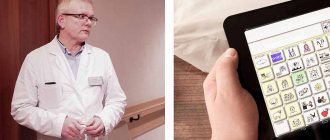Neurologist
SEMENOVA
Olga
5 years experience
neurologist, head of the office for diagnostics and treatment of cognitive disorders
Make an appointment
A disease in which a person experiences a decrease in verbal and logical thinking and other speech perception disorders are manifested is called sensory aphasia. Unlike other forms, sensory is considered mild; the patient is not able to perceive individual words and short phrases in all cases. A person with this type of disorder hears, but not as expected; words sound as if they are in another language. Against this background, anxiety intensifies, and disorientation in space is possible.
Signs and causes of sensory aphasia
Sensory aphasia can result from a wide range of causes. This disease can be caused by both diseases of the cardiovascular system and traumatic injuries to the head and central nervous system. The most common causes of sensory aphasia are:
- Acute and transient disorders of cerebral blood flow, for example, embolism or hemorrhagic stroke. Embolization can occur as a result of the presence of an unstable atherosclerotic plaque in the bed of one of the carotid arteries or as a result of thrombus entry from the left atrial appendage in arthimogenic conditions.
- Traumatic head injuries, most often occurring in transport accidents. Contusions and traumatic brain injuries can lead to immediate damage to cortical and subcortical structures or delayed damage with the development of cerebral edema.
- Oncological processes localized in the cranium. Benign or malignant tumors can be a significant factor in the development of sensory aphasia.
It is important to note that the following branches entering the middle cerebral artery basin are most often involved in the formation of the lesion:
- Inferior branch of the middle cerebral artery;
- Posterior temporal artery;
- Artery of the angular gyrus.
Forms of sensory aphasia
There are several significant clinical forms of sensory aphasia that are characteristic of sensory aphasia. When additional pathological foci of the cortical substance join the affected Wernicke's area, new symptoms of impaired speech function appear. In this regard, neurologists distinguish the following forms of aphasia:
Semantic aphasia
With this aphasia, there is a violation of the recognition of logic and the relationship of words and objects. This is especially true for spatial perception.
Acalculia-aphasia
In this case, the key symptom is the formation of a localized disorder of speech function. Namely, counting violations. At the same time, the patient’s other forms of speech are not affected.
Sensorimotor aphasia
Lack of speech awareness is associated not only with damage to the cortical part of the auditory analyzer, but also with a violation of articulatory function. In other words, a person cannot correctly evaluate gestures when pronouncing a specific word like another person. Same with myself. The patient himself is not aware of his illness and is very irritated in situations where he is not understood.
Total aphasia
With this option, the victim has a combination of different types of functional speech disorder. The patient has impairments in written and oral speech. In this case, the patient does not perceive someone else’s speech and also cannot answer anything himself.
AFFERENT MOTOR APHASIA
Afferent motor aphasia occurs with damage to the secondary zones of the postcentral and inferior parietal parts of the cerebral cortex, located posterior to the central or Rolandic sulcus.
There are two types of this aphasia. The first type of aphasia is observed with damage to the postcentral parts of the left hemisphere in both right-handers and left-handers, and is characterized by a complete loss of expressive speech. The second type of aphasia is observed in persons who were retrained in preschool and primary school age from the left hand to the right.
In the first variant of afferent kinesthetic motor aphasia, severe apraxia of the articulatory apparatus can lead to a complete absence of spontaneous speech. Attempts to arbitrarily repeat sounds lead to chaotic movements of the lips and tongue and literary substitutions. Patients split a closed syllable into two open ones, split up consonant clusters in a syllable, and omit consonant sounds. And at the same time the words here, there, here, etc. sound like tu-t, ta-t, vo-t, etc.
In the process of complex treatment of patients after a stroke at the Vremena Goda clinic, there is a rapid restoration of understanding of situational conversational speech, understanding of the meanings of individual words, and the ability to follow simple instructions. Patients have been experiencing specific features of impaired understanding for a long time. This is due to secondary phonemic hearing impairment. With this form of aphasia, difficulties arise in recognizing by ear words with sounds that have common features in the place of words with sounds that have common features in the place and method of articulation (rough - front-lingual, sonorant - vowels, etc. There are difficulties in understanding lexical means languages that convey various complex spatial relationships.
Difficulties in understanding are caused by verbs with prefixes (wrap, return, etc.), in understanding the meanings of personal pronouns used in indirect cases, which is explained by the lack of subject orientation in them, the abundance of phonemic changes (for example, me-me-me).
Reading and writing disorders depend on the severity of apraxia of the articulatory apparatus. In the process of neurorehabilitation in our clinic, the restoration of internal reading often precedes the restoration of written speech. When writing words under dictation, when naming objects in writing, when trying to communicate in writing with others, all articulatory difficulties affect themselves, i.e. There are numerous literary paragraphs reflecting a mixture of vowel and consonant phonemes that are close in place and method of articulation; consonants (sonorant) are omitted.
In the second variant of afferent motor aphasia, patients have difficulty maintaining the order of letters in a word, imagining their mirroring, skipping vowels, or writing all the consonants first, and then the vowels, and they retain the idea of the presence of a sound in a word, for example, skipping the letter “е” ", in the word "leads", the patient puts two dots over the "d".
Symptoms
Clinical manifestations of sensory aphasia have a number of specific signs that help make a quick and effective differential diagnosis. These signs include:
- Fluent speech or logorrhea, replete with a large number of allegorical expressions and paraphrases. The patient misses nouns, and I compensate for such speech defects with a large number of verbs, prepositions and conjunctions. Speech becomes verbose, but uninformative.
- “Jargnonic aphasia” is a continuous stream of neologisms, proverbs, sayings and paraphrases.
- Strong excitement up to the development of a paranoid state.
- Impaired understanding and perception of speech. The patient has difficulty or does not perceive simple questions at all, for example, a request to introduce himself or say who he is, but is able to follow simple commands, for example, turn his head or introduce himself. It is also important to note that the patient does not understand his own problem and becomes very irritated when the interlocutor does not perceive his speech well.
- Right-sided hemianopsia or upper quadrant hemianopsia. Loss of visual fields - when reading books, the victim will completely not notice the left page when reading the text.
- Smoothing of the nasolabial fold - the face becomes like a mask.
- Impairment of written speech.
There is also pure sensory aphasia (subcortical), when only the understanding of oral speech is impaired, but the understanding of written information, and therefore what is read, is preserved. Another form is also distinguished - transcortical sensory aphasia, which is characterized by the preservation of the ability to repeat oral speech, despite the lack of its perception and understanding. The main problem is that the patient hears the address to himself, but cannot interpret the meaning of what the interlocutor said. The native language is perceived as if it were foreign.
Sensory aphasia in rare cases occurs as an independent lesion of the auditory zones located in the brain, since in almost 85% of cases the damage involves several areas of the brain responsible for a wide variety of functions of the victim’s body. For example, with a stroke, sensory aphasia is often combined with paresis or paralysis of skeletal muscles on the side opposite the lesion. In the case of an infectious-inflammatory process: abscess, meningitis, encephalitis, there will be signs of general intoxication of the body and febrile syndrome, as well as cerebral symptoms. In the case of encephalitis, specific changes will be added to the cerebrospinal fluid - cerebrospinal fluid.
Specific signs of sensory aphasia in children
Sensory aphasia in childhood can be confused with alalia - the primary absence of speech, but there is a difference: if with alalia speech does not shift from the initial level of development, i.e. does not progress and does not undergo regression, then with aphasia a sharp degradation in the development of speech function, which has already been formed in a person, is noticeable. Since in childhood the speech function is not yet fully formed, there are specific signs for aphasia:
- As a rule, there is a rapid development of the disease and rapid recovery of speech function. Lack of recovery progress over several weeks is a poor prognostic sign for further recovery and indicates more serious brain damage.
- Restoration of speech function is carried out by increasing the activity of neighboring areas of the cortex, which to some extent are able to compensate for the neurological deficit. In adults, the restoration of speech function is carried out due to the formation of new logical connections and a developed conceptual apparatus.
- Scanty symptoms. Very often, it is difficult to determine the specific type of aphasia in children, since their speech function is not sufficiently developed. As a result, the conditions for revealing the full clinical picture of sensory aphasia are not created.
Main types of aphasia: clinical picture
In accordance with the severity of the pathology, a distinction is made between partial (when full speech alternates with disturbances) and total (when speech has significant disturbances) aphasia. Depending on the damage to a particular brain area, there are six main types; let’s look at each in more detail.
Semantic aphasia
This form appears when the parieto-occipital region of the left hemisphere is affected. People have a complete misunderstanding of speech formulations that reflect spatial relationships, and their understanding of the text they are viewing is impaired. Also, there are difficulties in completing tasks containing complex syntactic structures. In this case, understanding is not impaired when perceiving simple sentences, but the person forgets the names of familiar objects. Speech is preserved, but writing and reading slow down significantly. Many people develop acalculia, a pathology in which a person does not understand numbers and arithmetic operations.
To diagnose this form of the disease, experts come up with tasks that require quasi-spatial synthesis. For example, comparative sentences: “Ira’s curls are darker than Masha’s, but lighter than Dasha’s curls. Who has the darkest hair?" They also resort to solving simple arithmetic problems.
Acoustic-mnestic aphasia
It appears when the middle parts of the temporal region are affected, which are located outside the nuclear zone of the auditory analyzer. With this form, a person suffers from difficulty retaining information received by ear in memory. The volume of memorization is significantly reduced, as a result of which a person is not able to repeat a simple combination of several words after a speech therapist, or to grasp the meaning of speech in difficult conditions (for example, at a fast pace, during a conversation with several people at once). It is worth noting that difficulties with speech communication are compensated for by increased speech activity. Some people have distorted visual representations of an object and have severe problems in naming various objects. Memory disorder occurs with impairment of writing.
Sensory aphasia
It manifests itself when a person suffers damage to the main organ of the central nervous system in the area of the temporal lobes. Sensory aphasia is divided into three subtypes: cortical, subcortical and transcortical. The cortical subtype is a severe disorder that affects Wernicke's speech area (responsible for the perception and processing of sounds). In such a situation, a person does not understand and does not pronounce sounds. With the subcortical subtype, a person experiences a distortion in the transmission of impulses from the centers that perceive sound information.
With the transcortical type of aphasia, a disturbance in the conduction of nerve impulses between Wernicke's and Broca's centers occurs. But the ability to perceive light speech structures remains. In the first 4-8 weeks after injuries of this type, the patients’ speech consists of a chaotic set of sounds and syllables, so the meaning of the phrases is incomprehensible to other people. Regardless of the subtype, the following symptoms of sensory aphasia are distinguished:
- lack of ability to perceive speech normally (with intact hearing);
- deviations from the nervous system (anxiety and aggression associated with a lack of understanding of what is happening);
- the ability to pronounce sounds and words, but devoid of meaning;
- cramps (spasms) in the body;
- deterioration of visual function.
Motor aphasia
It is of two types - afferent and efferent. The disease can progress in different ways. In the first case, the patient has a lack of instinctive speech, a speech embolus. Due to the fact that articulation is severely impaired, a person is not able to determine what needs to be done to pronounce a specific sound. During conversations, patients often rearrange individual letters or words.
In the second case, the person retains situational speech, but repetition is severely impaired. In this form, a violation of the understanding of oral speech is diagnosed. Characterized by uncontrolled speech, which often consists of a random collection of letters and words. Speech is poor and many patients do not use prepositions.
Patients are bothered by kinetic apraxia, which makes it impossible to switch from one position to another. Against this background, rearrangements of sounds and syllables occur in human speech. The key difference between this form of the disease is long stops. In this case, the pronunciation of individual sounds is not impaired at all. Also, gross violations are noted (in particular, dyslexia).
Dynamic aphasia
This form appears when parts of the left dominant hemisphere are damaged. The main speech defect is the difficulty or impossibility of active speech. A person pronounces individual sounds without problems, repeats phrases without difficulty, but the communicative function is impaired. With a strong severity of the disorder, not only a speech defect is diagnosed: pronounced echolalia and echopraxia appear (when a person mechanically repeats his opponent’s actions).
The patient has impaired expressive speech. There are several variants of dynamic aphasia, which differ in varying degrees of impairment of communicative function: from the absence of expressive speech to a slight impairment of speech communication. Such patients require regular speech stimulation. Their speech is characterized by the presence of speech patterns. The patients' spontaneous, detailed utterance is impaired. For example, when retelling a story he has read, he pronounces out loud certain moments that are not connected with each other (there is no semantic link).
Total aphasia
With severe damage to the cortex of the dominant hemisphere, which affects the motor and sensory speech areas, total aphasia appears. The person has no speech at all; he does not perceive the phrases of others. Damage occurs to many speech areas of the brain. This is the most severe degree of damage. All types of aphasia can be corrected, but treatment for total aphasia takes the longest. It is worth noting that sometimes mixed forms occur, for example, afferent-efferent.
Great importance is paid to developmental activities. They are compiled individually for each patient, taking into account age and psychological characteristics. In a calm and familiar environment, the patient is given a set of exercises that perfectly develop the functioning of the senses and contribute to the development of correct perception of information. Such classes are practiced in different formats: in the form of active motor exercises in a special room, and in the patient’s room.
Diagnostics
Diagnosis of sensory aphasia is primarily aimed at identifying the cause of the disease. The diagnostic study must be comprehensive and consist of the following stages:
- Consultation and questioning of the patient to determine the history of life and illness. Also, during the initial appointment, the doctor examines the patient and studies specific symptom complexes. The neurologist looks for concomitant diseases that manifest themselves not only by external signs, but also by conducting additional tests and studies. During the examination, a specialist neurologist determines the lesions, the nature and course of the pathological process, assesses the general condition of the patient, as well as the blood supply to the brain. Makes a prognosis and subsequent treatment plan in accordance with the patient’s age. Its individual characteristics and concomitant somatic diseases. As well as the level of damage to the central nervous system.
- Consultation with a speech therapist, psychologist and other specialists. They determine the severity of the speech function defect and coordinate further tactics for restoring lost functions with the attending physician.
- Conducting additional instrumental and laboratory studies to verify and clarify the clinical diagnosis. Studies such as computer and magnetic resonance imaging, electroencephalography, angiography of cerebral vessels are carried out. These studies are carried out to identify the level and area of brain damage, the presence of space-occupying formations in the nervous tissue, aneurysms and hemorrhages in the brain tissue, foci of abscess, and the consequences of a stroke.
Tests to determine left-handedness or right-handedness (right-handedness/left-handedness)
Determine the dominant eye. The patient is asked to look through a kaleidoscope or telescope (to which eye he brings the left or right one first).- Interlocking of fingers: upper position of the thumb (left, right).
- Cross your arms over your chest: “Napoleon pose”, which hand is on top - left, right.
- Determination of the size of the thumb nail.
- On which arm (left, right) is the venous system more developed?
- Determine which hand is 1-2 mm longer.
- Observe which leg is dominant in the sport.
- Which hand holds a pen, fork, spoon, brushes teeth, shoes.
- Which hand combs the hair, which side is the parting on the head.
- Which hand washes, digs, screws, cuts paper, cuts nails, unlocks a door, hammers nails, saws, etc.
- Which hand is more comfortable to play a musical instrument?
The patient's closest relatives should answer these questions to the doctor. The test can determine not only the leading hand (more than half of the answers), but also hidden left-handedness, if a left-handed type of reaction is detected in three or more questions.
Usually in left-handed aphasics
the prospects for speech restoration are better than for right-handers, since the functions of the right hemisphere remain largely intact. When the parietal and temporal lobes of the left hemisphere are damaged, speech restoration occurs based on the planning function of the frontal lobe of the left hemisphere, which allows the patient to gain motivation to learn. Difficulties in restoring speech in left-handers arise only with acoustic-mnestic and semantic aphasia. In left-handed people, dynamic aphasia practically does not manifest itself due to the high interchangeability of the functions of the posterior frontal parts of the brain.
Up
Treatment
The treatment process aimed at restoring the consequences resulting from aphasia requires a long time and enormous dedication, both from the patient and his relatives, and from medical personnel and specialists who have undergone special training. The restoration work of such a pathological condition consists of the following points:
- Pharmacological (drug) therapy. It mainly includes the use of drugs from the group of nootropics, drugs that increase the metabolism and trophic potential of the brain, vitamin therapy with neuroprotective B vitamins. Additional therapy is selected individually and prescribed in accordance with the cause of sensory aphasia. For example, in the case of a stroke, thrombolytic or hemostatic drugs are added, in the case of an infectious inflammatory lesion, antibiotics, non-steroidal anti-inflammatory drugs or antifungal agents are added.
- Session with a speech therapist. The main difficulty that arises when attempting to contact the victim is the lack of understanding of the specialist’s approach to the patient. Violation of communicative activity requires long-term correction and perseverance. There are also difficulties in interpreting what the patient says. Because his speech is uninformative. It is very difficult to identify the main idea. Consultations with a speech therapist help restore the patient’s vocabulary, correct pronunciation of sounds and meaningful speech. With the help of special exercises and equipment, you can actively interact with the patient even at home.
- Surgical interventions. In some cases, with deep or severe brain damage, the patient requires emergency surgery to eliminate the threat to life. In case of an aneurysm, clipping or sclerosis of the aneurysm can be performed using X-ray control. If aphasia is caused by tumor growth, then stereotactic surgery can be performed to destroy the tumor focus.
- Additional treatment methods can speed up the recovery processes in the victim’s nervous tissue, and also increase the effectiveness of the main therapy. In the treatment of sensory aphasia, methods such as physical therapy, massage, physiotherapeutic methods, and the use of computer programs that stimulate the speech center and improve speech abilities are used. A positive effect has also been noted in contact with animals, so the following can be used in therapy: hippotherapy, feline therapy and dolphin therapy.
At the Clinical Institute of the Brain there is a specialized rehabilitation and recovery center that deals with the correction of disorders in patients with aphasia. Together with treatment, we manage to achieve a quick, step-by-step recovery process. There is a close connection between treatment and rehabilitation, which helps to quickly adapt the patient to new living conditions, thereby significantly increasing the effectiveness of therapy and recovery.
How to treat aphasia, get rid of aphasia?
Sarklinik knows how to treat aphasia , speech disorders characterized by partial or complete loss of the ability to use words and phrases, how to get rid of aphasia in Saratov. A variety of reflexology treatment methods have helped many of our patients get rid of aphasia in right-handed and left-handed people. Effective treatment of aphasia gives excellent results; patients (children and adults) restore lost speech abilities and begin to understand their thoughts and the speech of others. On our website sarclinic.ru you can see a doctor for free and get a short answer on the treatment of aphasia.
Rehabilitation
Only daily classes with a speech therapist and other specialists will contribute to an active rehabilitation process. It is very important to correctly build a rehabilitation plan from simple to complex. To begin with, the victim must be adapted to new conditions. Only after a course of psychotherapy can one begin rehabilitation measures, since the patient must be motivated to recover.
The patient can also perform the following exercises at home:
- Simple questions: the patient is first asked questions with monosyllabic yes or no answers, then later they move on to open questions.
- Thematic dialogues are practiced with the gradual development of dialogue on specific topics;
- Writing and reading. Correction of the spelling and pronunciation of letters begins. Then syllables, which the patient then puts into words. In the future, with successful progress, they move on to writing dictations and reading short texts. The patient is asked to retell in his own words the story he read and answer questions about its content;
- A task aimed at matching pictures and text. The patient is asked to build a story, while laying out the pictures sequentially;
- Structuring pictures according to general properties and characteristics. The patient is given the task of arranging the pictures according to categories and highlighting common characteristics, for example, to separate some animals from others.
Clinical Brain Institute Rating: 4/5 — 12 votes
Share article on social networks
Diagnosis and treatment methods for aphasia in Moscow
The problem can be resolved with the help of qualified specialists. The disease requires elimination of the main cause and further correction. The speed of its correction largely depends on the degree of brain damage, so it is important not to delay a visit to a specialist. Diagnosis and treatment of speech disorders is carried out by specialists from the Department of Neurology.
At the initial appointment, the doctor collects anamnesis, collects complaints (in the case of aphasia, if it is impossible to independently describe the condition, close relatives are involved in the diagnosis), conducts a general examination for the presence of external abnormalities (in particular, drooping corners of the lips, decreased tone of the limbs).
Additionally, an examination by a neurologist in a team with a speech pathologist-speech pathologist is required so that the nature of the disorder can be assessed and appropriate corrective measures can be selected. Initiation of therapy requires testing, including assessment of the following symptoms:
- Spontaneous speech. Speech is assessed by the number of words spoken, the presence of spontaneous errors, and the frequency of pauses to select suitable words.
- Understanding. The patient is asked to point to objects that the specialist names and answer basic questions (“yes” or “no”).
- Enumeration of objects. The patient is asked to say the name of the specific object that the specialist points to.
- Reading and writing. The patient is given the task of writing any phrase and saying it out loud. This allows you to assess the degree of understanding and pronunciation.
- Semantic activity. The doctor demands to name all the animals that the patient remembers in one minute.
Programs:
Stroke Prevention
Outpatient diagnostic
Rehabilitation programs
Diagnosis of swallowing disorders and correction
Restoration and correction of speech disorders








